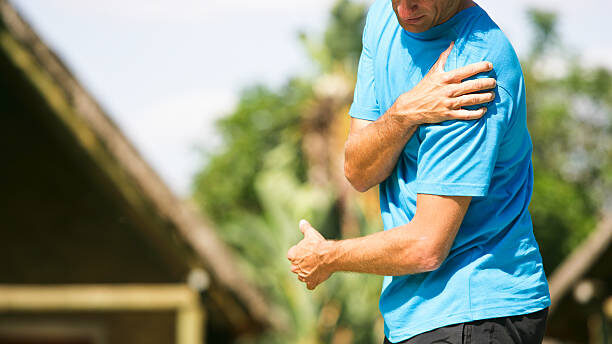Your rotator cuff is not a single muscle, but a group of muscles and tendons that surround your shoulder joint, keeping the humerus and scapula (upper arm and shoulder) connected, while allowing for a wide range of motion. Not only can a rotator cuff injury after a car accident result in pain and a reduced range of motion, but it can create persistent or recurring problems without proper treatment.
What can you expect if you suffer a rotator cuff injury in a car accident? How can you properly treat it? Here’s what you need to know.
Symptoms of a rotator cuff injury after a car accident
Pain is the most noticeable symptom of any rotator cuff injury after a car accident, although weakness and limited range of motion are also common. For example, you may have trouble lifting your arm, reaching behind you, or performing normal tasks like brushing your hair.
If your rotator cuff is torn (as opposed to, say, strained), you may experience sharp or sudden pain, as well as pain that radiates down your arm. Pain in the upper back and neck is also common. A limited range of motion could prevent you from reaching overhead, and muscle weakness could make it difficult to lift objects.
Swelling is possible with a torn rotator cuff, and you may experience popping or clicking when you move your shoulder. Many patients suffering from a damaged rotator cuff will experience difficulty sleeping when pressure is placed on the injured shoulder. If you experience these symptoms following a car accident, it’s best to see a doctor for a diagnosis to determine the extent of the injury.
Rest and recovery
For minor rotator cuff injuries after a car accident, the body may repair itself, as long as you don’t cause further harm. This could mean resting, icing the area, and possibly wearing a sling to immobilize your arm, allowing for faster healing and recovery.
Rehabilitation
For rotator cuff injuries that won’t heal on their own, there are several possible treatment options, but rehabilitation is often the first recommendation. Even after healing, it’s normal to experience lingering weakness or limited range of motion. Personalized rehabilitation with an experienced physical therapist is the best way to increase strength and mobility without causing further harm.
Chiropractic care
In addition to physical therapy, it can be beneficial to see a chiropractor for manipulation, massage, stretching, and holistic care. Often, rotator cuff injuries after a car accident are tied to other pain, such as in the neck and back, as well as the arm. Chiropractic care addresses all areas of pain for holistic healing and pain relief.
Other treatment options
In some cases, you may experience ongoing pain caused by your rotator cuff injury car accident, even after rehabilitation. Steroid injections may be an option, but if you have significant damage that simply won’t heal, you may need surgery. This is especially common when a tendon is torn. Surgery is usually a last resort, but it depends on your injury.
Even a minor car accident can result in a severe injury. The human body isn’t built to sustain the extreme force, and victims of a car accident can endure anything from whiplash to a dislocated hip or shoulder.
Oftentimes, the adrenaline rush of a car accident delays identifying injuries. However, the longer your injury goes untreated, the more lingering effects it can have.
Rotator cuff injury vs dislocated joint
Telling the difference between a dislocated joint car accident and a rotator cuff injury car accident is difficult because a lot of the symptoms are the same. Both kinds of injuries can cause intense pain, protruding at the joint, and a minimal range of motion.
While shoulder dislocations account for 95% of the joint dislocations recorded by the National Highway Transportation Safety Administration’s Special Crash Investigations Program, other dislocation sites include:
- Hips
- Vertebrae
- Elbows
- Jaw
- Fingers
- Knees
- Ankles
Any dislocation can lead to complications. The surrounding tendons, ligaments, and muscles around the joint can tear or you can damage nerves and blood vessels near the joint.
How chiropractic care helps
When you experience a dislocated joint from a car accident, you should have the joint restored to its proper position immediately. This is why it’s important to visit a chiropractor to determine if the damage you sustained affected your shoulder joint or rotator cuff. Even after resetting the joint, you may suffer from inflammation, soft tissue damage, and a limited range of motion.
Your trusted car accident chiropractor can address these concerns by treating and adjusting based on your needs, not just supplying you with pain medications.
Restore alignment
A reset joint can still be misaligned and strain the surrounding joints, muscles, ligaments, and tendons as it overcompensates for the injury.
The muscles around the joint may feel stiff and sore from the dislocation and discomfort due to misalignment. Car accident chiropractors use gentle, safe adjustments to align the joints so they can function properly and regain their full range of motion.
Re-establish healthy blood flow
Healthy blood flow is critical to the healing process for both dislocated joints and rotator cuff injuries after a car accident. Blood brings oxygen and nutrients to the injury site to promote healing. Chiropractic care includes therapeutic massage, adjustments, and muscle manipulation to stimulate proper blood flow.
Reduce inflammation
Swelling and inflammation are part of the body’s natural healing response. However, too much of an inflammatory response can make movement uncomfortable and cause blood to stagnate at the injury site.
Your car accident chiropractor can restore movement and reduce inflammation through adjustments and exercises, promoting healthy mobility and function of the injured joint.

Other injuries that will affect your range of motion
Dislocated joints and rotator cuff damage aren’t the only two injuries that can greatly affect your range of motion following a car accident. After the collision, you may find yourself full of aches, pains, and injuries that limit your range of motion and mobility. Seeing a chiropractor specializing in car accident injuries can ensure the new limits on your range of motion don’t become permanent.
Several common car accident injuries affect the soft tissue, leading patients to disregard their symptoms. Unfortunately, these injuries can cause lasting damage. Three such injuries include:
1. Whiplash
Whiplash is a soft tissue injury often resulting from a car accident. It occurs when the neck experiences a rapid, forceful movement, like a whip cracking. This motion strains or sprains the neck muscles.
When patients follow a treatment plan for whiplash that includes exercises and chiropractic care, it often heals within a few weeks. However, when whiplash goes untreated, patients may experience chronic neck pain, headaches, and loss of range of motion in the neck.
2. Sprains
A sprain occurs when ligaments become stretched or torn. Ligaments are soft tissues that connect bones. Ligaments in the back, wrists, ankle, neck, or knee often sustain damage through the impact of a car accident.
Sprains may cause pain, swelling, bruising, and stiffness. In addition, the joint may become difficult to move. Sprain severity can vary greatly. However, severe sprains can prevent victims from engaging in everyday activities for an extended period.
3. Strains
While strains and sprains are often used interchangeably, they affect different tissues. Sprains solely impact ligaments, while strains affect muscles and tendons. For example, strains resulting from a car accident occur in the lower back due to the force of the impact.
A strain can cause:
- Bruising
- Tenderness
- Inflammation
- Swelling
- Muscle spasms
- Lack of range of motion
- In severe accidents, a victim may tear a muscle in the lower back
What to do next
Chiropractors can treat joint misalignments, rotator cuff injuries, joint-based pain, and soft tissue injuries. For example, electrical muscle stimulation (EMS) tools can decrease inflammation, reduce muscle spasms, and relieve pain.
Additionally, chiropractic adjustments realign the vertebrae to take pressure away from the site of the strain or sprain, which increases mobility and alleviates pain. Many chiropractors also offer therapeutic massages to loosen muscle stiffness and tension and increase the effectiveness of a chiropractic adjustment.
After a car accident, visiting a specialized chiropractor is essential. If you’ve been affected by a rotator cuff injury after a car accident or any other kind of damage, get in touch with Veeva Clinic and begin your healing process today.

